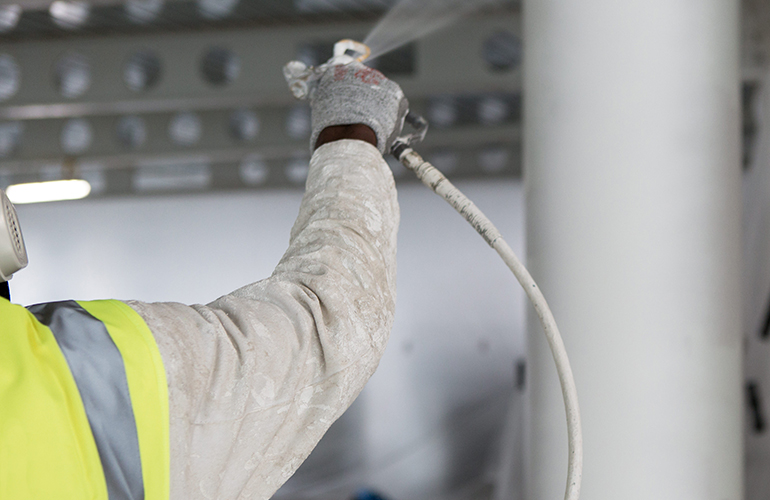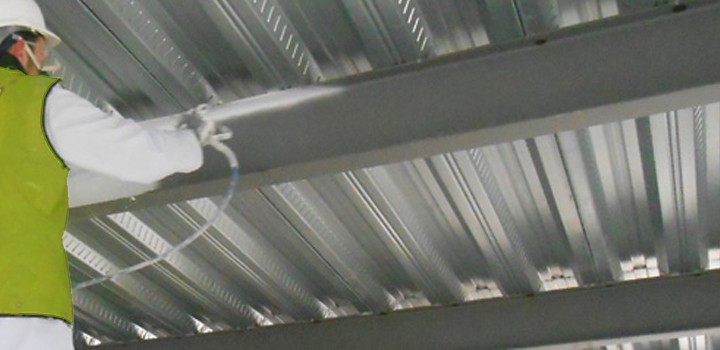Strategic Intumescent Paint Coatings for Steel Structure Fireproofing
Understanding the technical advantages of these coatings enables residential and commercial property owners to make informed fireproofing decisions.

Steel structures offer strength and durability, but in high-temperature fires, unprotected steel can lose structural integrity within minutes. Intumescent paint coatings provide a proactive solution, expanding under heat to form an insulating char layer that slows temperature rise and maintains load-bearing capacity. Understanding the technical advantages of these coatings enables residential and commercial property owners to make informed fireproofing decisions.
How Intumescent Paint Protects Steel in Fires
Intumescent paints chemically react to heat, forming a protective char that slows heat transfer to steel. This section explains the mechanism and performance impact.
Chemical Reaction and Char Formation
When exposed to high temperatures, the paint undergoes a chemical reaction, releasing non-flammable gases that expand the coating. The resulting char layer insulates steel, delaying critical temperature thresholds.
Thermal Barrier Function
The expanded char reduces heat flux to the steel surface, allowing structural elements to maintain strength longer. This delay is crucial for evacuation, firefighting, and preventing building collapse.
Advantages Over Traditional Fireproofing
Unlike cementitious or board-based fireproofing, intumescent paints are thin, lightweight, and aesthetically flexible. They conform to complex geometries and require less space, making them ideal for both new construction and retrofit applications.
Types of Intumescent Coatings and Performance Metrics
Selecting the best intumescent paint service involves understanding formulations, thickness requirements, and fire resistance ratings.
Solvent-Based vs Water-Based Coatings
Solvent-based paints offer high adhesion and quick curing but may emit volatile organic compounds (VOCs). Water-based formulations are eco-friendlier, with lower VOC levels, but may require additional layers to achieve equivalent fire resistance.
Fire Resistance Ratings
Coatings are rated according to standardized tests, typically expressed in minutes or hours of protection at specific steel section thicknesses. Properly applied, intumescent paint can extend steel fire resistance from 30 minutes up to 120 minutes or more.
Comparison Table: Key Performance Factors
| Feature | Intumescent Paint | Cementitious Coating | Fireproof Board |
|---|---|---|---|
| Thickness Requirement | 0.5–2 mm | 10–50 mm | 12–25 mm |
| Weight | Light | Heavy | Moderate |
| Aesthetic Flexibility | High | Low | Low |
| Application Complexity | Moderate | Moderate | High |
| Fire Resistance Duration | 30–120+ minutes | 30–120 minutes | 60–120 minutes |

Application Considerations for Steel Structures
Proper surface preparation and coating techniques are essential to ensure performance and longevity.
Surface Preparation
Steel surfaces must be clean, dry, and free from rust or contaminants. Primers may be required for enhanced adhesion and corrosion resistance.
Layering and Thickness
Achieving rated fire resistance requires applying the correct thickness evenly. Multi-layer applications may be necessary, especially for water-based formulations or intricate steel profiles.
Environmental Conditions
Temperature, humidity, and ventilation during application affect curing and coating performance. Controlled conditions ensure optimal adhesion and expansion under heat.
Long-Term Performance and Maintenance
Intumescent coatings provide durable fire protection but require inspection and maintenance for sustained effectiveness.
Durability in Building Lifespan
High-quality paints resist cracking, peeling, and UV degradation. They maintain fire resistance for decades when properly applied and protected from mechanical damage.
Maintenance Practices
Periodic visual inspections identify any damage or wear. Touch-ups and recoating extend protective life, ensuring the coating performs as intended in fire events.
Compatibility With Structural Design
Intumescent coatings integrate seamlessly with steel architectural elements. They allow exposed steel aesthetics while providing certified fireproofing without altering structural design.
Strategic Integration for Residential and Commercial Buildings
Incorporating intumescent paint into fireproofing plans improves safety, compliance, and long-term performance.
Code Compliance and Certification
Intumescent coatings are tested to comply with international standards such as ASTM E119 and EN 13381. Selection should align with local building codes and structural fire resistance requirements.
Cost-Effective Fireproofing Strategy
Thin-film application reduces material and labor costs compared with thick board or cementitious systems. It also minimizes structural load, critical in retrofit projects or lightweight construction.
Holistic Safety Planning
Integrate coatings with other fire protection measures, such as sprinklers, alarms, and compartmentalization, for comprehensive fire resilience in both residential and commercial properties.

Conclusion
A professional insulation contractor offers a strategic, technically advanced approach to fireproofing steel structures. By expanding under heat to form insulating char, these coatings delay steel temperature rise and maintain structural integrity during fire events. Their thin profile, aesthetic flexibility, and compatibility with complex steel geometries make them ideal for new construction and retrofit applications.
Incorporating intumescent coatings into a comprehensive fire safety strategy ensures enhanced building resilience, occupant protection, and compliance with safety codes. Regular maintenance and correct application maximize long-term performance, providing cost-effective, reliable fire protection for both residential and commercial structures.
FAQs
How does intumescent paint protect steel structures?
It expands under high temperatures to form a char layer that insulates steel, delaying heat transfer and preserving structural strength during fires.
What determines the fire resistance rating of intumescent coatings?
Thickness, formulation type, steel section, and standardized testing (ASTM E119, EN 13381) determine the duration of fire protection.
Are water-based intumescent paints as effective as solvent-based?
Yes, with proper application and thickness, water-based paints can achieve equivalent fire resistance while offering lower VOC emissions.
Can intumescent coatings be applied to existing steel structures?
They are suitable for retrofit applications, provided surfaces are cleaned, primed, and prepared to ensure adhesion and performance.
How is maintenance performed on intumescent paint coatings?
Regular inspections identify cracks, peeling, or damage. Touch-ups or recoating maintain the fire-resistance rating throughout the building’s lifespan.
Reviewer: Jacob Wright has 6 years of experience in spray foam insulation. He reviewed this content and made sure it focused on the real decisions small business owners deal with every day.